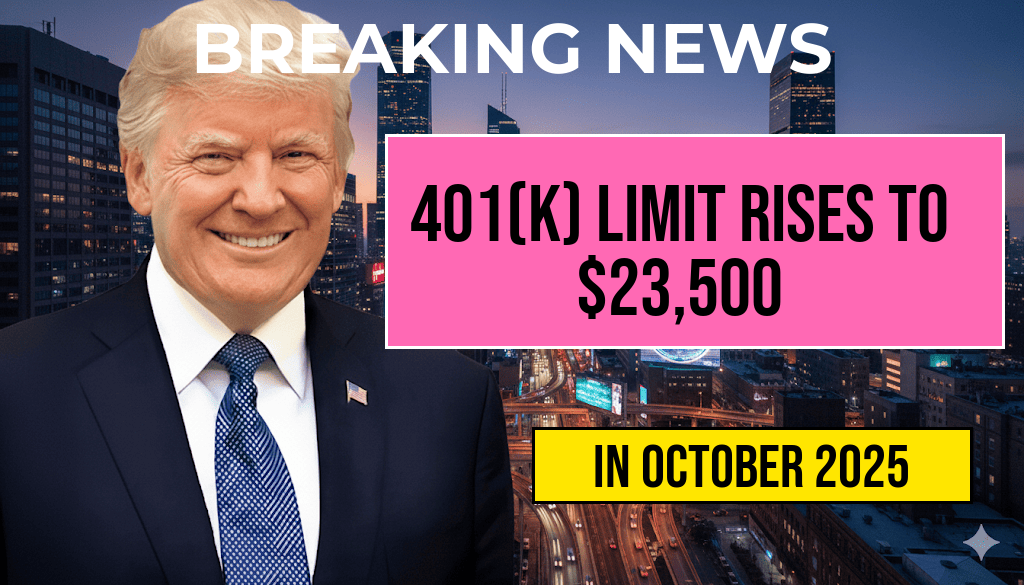The Internal Revenue Service (IRS) has announced significant updates to the 2025 contribution limits for 401(k) retirement plans, setting the maximum employee contribution at $23,500. This adjustment reflects ongoing efforts to keep pace with inflation and offers workers increased opportunities to bolster their retirement savings. The new limit, up from the current $22,500 in 2024, marks a notable rise, allowing employees to contribute more toward their future financial security. Employers and financial advisors are expected to emphasize these changes as part of broader retirement planning strategies for 2025. With the rising cost of living and the importance of early, consistent savings, this increase aims to support Americans in maximizing their retirement contributions and preparing for a more stable financial future.
Understanding the 2025 401(k) Contribution Limits
What Has Changed?
The key update for 2025 is an increase in the employee contribution limit for 401(k) plans. Employees can now contribute up to $23,500, compared to the previous year’s limit of $22,500. This increase represents about a 4.4% rise, aligning with inflation adjustments mandated by federal law. The limit applies solely to individual contributions; total contribution limits, which include employer matches and other plan contributions, have also increased.
Other Important Limits for 2025
| Limit Type | 2024 | 2025 | Change |
|---|---|---|---|
| Employee contribution limit | $22,500 | $23,500 | +$1,000 |
| Catch-up contribution (age 50+) | $7,500 | $8,000 | +$500 |
| Total contribution limit (including employer contributions) | $66,000 | $73,500 | +$7,500 |
Implications for Retirement Planning
Enhanced Savings Capacity
The uplift in contribution limits provides an immediate opportunity for workers to accelerate their savings. For employees who have been maxing out their contributions, the increase allows for additional room to invest without changing their current savings behavior. Those who haven’t yet reached the previous limit may find it advantageous to boost their contributions to leverage the new cap.
Impact on Employers and Match Strategies
Employers often match a portion of employee contributions, and the increased limits could influence their matching strategies. Some organizations may consider revising their policies to encourage higher contributions, aligning with the new thresholds to help employees optimize their retirement savings.
Retirement Readiness and Financial Security
As life expectancy rises, Americans face longer retirement periods, making higher contribution limits a crucial tool in achieving financial security. Experts suggest that individuals who increase their contributions early in their careers stand to benefit significantly from compounding growth over time. Financial advisors recommend evaluating retirement plans annually to adapt to changing limits and personal circumstances.
Additional Considerations for 2025
Roth vs. Traditional Contributions
The increased limits apply across both Roth and Traditional 401(k) options. Employees should consider their current tax situation and future income expectations when choosing between the two. Roth contributions are made with after-tax dollars, offering tax-free withdrawals in retirement, while Traditional contributions are made pre-tax, reducing taxable income today.
Catch-Up Contributions for Older Workers
Workers aged 50 and older can make additional “catch-up” contributions, which have risen to $8,000 in 2025. This feature allows those nearing retirement to accelerate their savings and bridge potential gaps in their nest egg.
Retirement Planning Resources
- Investopedia: 401(k) Plan
- Social Security Administration: Retirement Age and Benefits
- Federal Reserve: Inflation and Retirement Savings
Looking Ahead
The 2025 increase in 401(k) contribution limits demonstrates ongoing efforts to adapt retirement savings policies to economic realities. As the federal government continues to adjust these thresholds annually, individuals are encouraged to review their savings strategies regularly. Maximizing contributions within the new limits can be a key step toward building a more comfortable retirement, especially in a landscape where inflation and longevity pose ongoing challenges.
Frequently Asked Questions
What is the new 2025 401(k) contribution limit?
The 401(k) contribution limit for employees will increase to $23,500 in 2025, allowing participants to save more for their retirement.
Who is eligible to contribute the maximum amount in 2025?
Eligible employees who participate in their company’s 401(k) plan and are under the age of 50 can contribute up to the $23,500 limit. Those aged 50 and above can make additional catch-up contributions.
Are there catch-up contributions allowed in 2025?
Yes, employees aged 50 and older are permitted to make catch-up contributions of an additional $7,500 in 2025, bringing their total potential contribution to $31,000.
How does the increased 401(k) contribution limit affect retirement savings?
The higher contribution limit enables employees to save more each year, potentially increasing their retirement savings and reducing the time needed to reach their financial goals.
When do the new 401(k) contribution limits take effect?
The increased limit to $23,500 for 2025 applies to the plan year, starting from January 1, 2025, allowing employees to make contributions up to this amount throughout the year.






